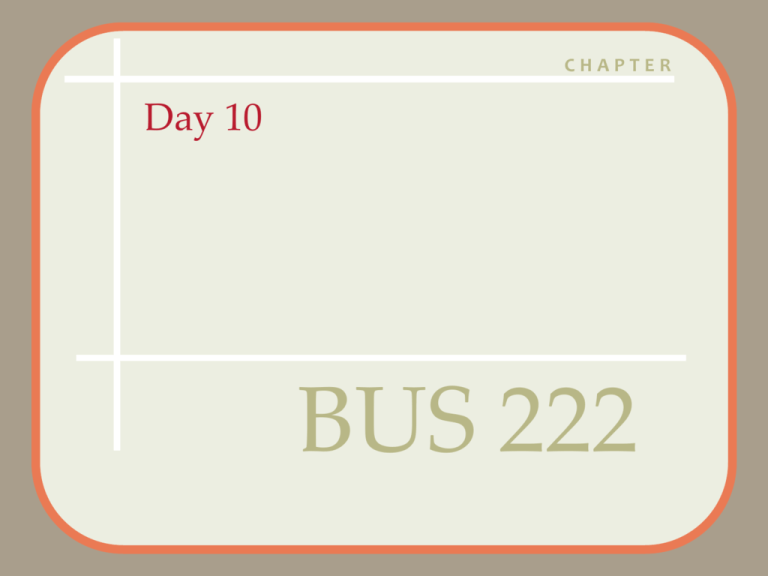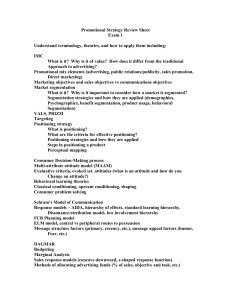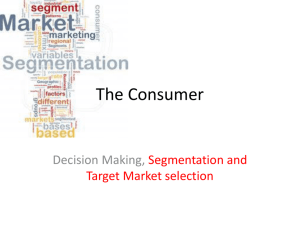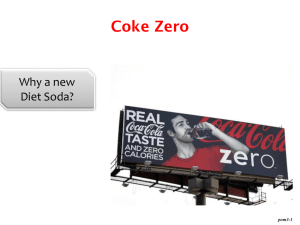
CHAPTER
Day 10
BUS 222
• Questions
• Assignment 3 Due
• Assignment 3 Posted
Agenda
– Due March 6
– Marketing Assignment 4.pdf
• Begin Discussion on Segmentation, Targeting and Positioning (30 min)
• Quiz 2 Is Today (45 min)
–
–
–
–
–
Chaps 5, 6 & 7
15 M/C , 45 min.
Open Book, Open Notes
Lowest quiz score gets dropped
Extra Credit Question on Fast Food Restaurants in Sochi, Russia
CHAPTER
SEGMENTATION,
TARGETING, AND
POSITIONING
McGraw-Hill/Irwin
08
Copyright © 2012 by The McGraw-Hill Companies, Inc. All rights reserved.
Segmentation, Targeting, and Positioning
LEARNING OBJECTIVES
LO1 Identify the five steps in the segmentation,
targeting and positioning process.
LO2 Outline the different methods of segmenting a
market.
LO3 Describe how firms determine whether a segment
is attractive and therefore worth pursuing.
LO4 Articulate the difference among targeting
strategies: undifferentiated, differentiated,
concentrated, or micromarketing.
LO5 Define positioning, and describe how firms do it.
Segmentation, Targeting,
Positioning Process
Step 1: Establish Overall
Strategy or Objectives
Check Yourself
Derived from mission
and current state
Step 2: Segmentation Methods
Segmentation
Geographic Segmentation
©ImagineChina
Demographic Segmentation
Most common
segmentation strategy
©Stockbyte/Getty Images
U.S. Census Bureau Website
Balancing Act Career Moms
Psychographic Segmentation
Psychographic
Self-values
Self-concept
Lifestyles
©Benetton Group SPA; Photo by: Oliviero Toscani
VALS Framework
Take the Survey!
VALS Website
Geodemographic Segmentation
Claritas Website
66 possible segments
ESRI Tapestry
http://www.esri.com/data/esri_data/tapestry.html#
tapestry-segmentation.pdf
State Farm Not Insuring Mississippi
Benefit Segmentation
©image100/PunchStock
©image100/PunchStock
Michael Hevesy/Photodisc/Getty Images
Behavioral Segmentation
Occasion
segmentation
Royalty-Free/CORBIS
Loyalty
segmentation
Check Yourself
1.
What are the various segmentation
methods? (6)
Step 3: Evaluate Segment Attractiveness
Identifiable
• Who is in their market?
• Are the segments unique?
• Does each segment require a unique marketing mix?
Liquidlibrary/Dynamic
Graphics/Jupiterimages
Liquidlibrary/Dynamic
Graphics/Jupiterimages
Comstock Images/JupiterImages
Substantial
©Jerry Arcieri/Corbis
• Too small and it is
insignificant
• Too big and it might
need it’s own store
Reachable
Know the
product exists
Understand
what it can do
©Digital Vision/PunchStock
Recognize how
to buy
Responsive
Customers must:
React positively to firm’s
offering
Move toward the firms
products/services
Accept the firm’s value
proposition
Profitable
Profitable Segments
©Comstock/PunchStock
Is this segment profitable?
• Segment size = 60 million
(<15 yrs)
• Segmentation Adoption
Percentage = 35%
• Purchase Behavior =
$500 x 1 time purchase
• Profit margin % = 10%
• Fixed Cost = $50M
60M * 0.35 = 21M
21M * $500 = $10,500M
$10,500M * 0.10 = $1,050M - $50M = $1,000M
Step 4: Selecting a Target Market
• Conde Nast has more than 20
niche magazines focused on
different aspects of life.
©M Hruby
Segmentation Strategy
Step 5: Develop Positioning Strategy
Positioning
Methods
•Value
•Salient Attributes
•Symbol
•Competition
Photo by Tiffany Rose/WireImage/Getty Images
Positioning
Green Giant for Business Wire via Getty Images
Product Positioning
Source: http://www.tutor2u.net/business/marketing/brands_positioning.asp
Positioning Steps
1. Determine consumers’ perceptions and
evaluations in relation to competitors’.
2. Identify competitors’ positions
3. Determine consumer preferences.
4. Select the position.
5. Monitor the positioning strategy.
Perceptual Maps
Check Yourself
1.
What is a perceptual map?
2.
Identify the five positioning steps.









